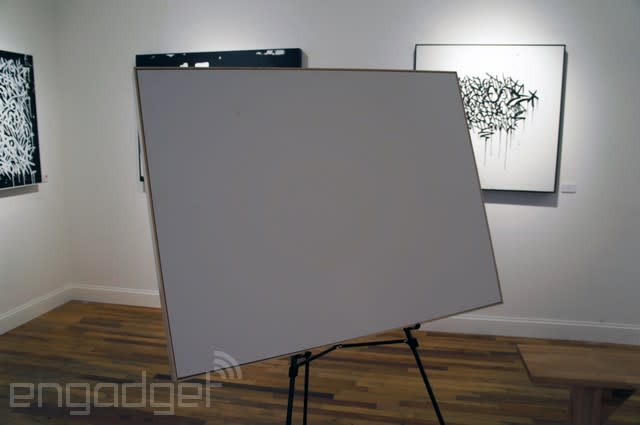Soundwall is art that demands to be seen... and heard

Hang something like a painting on your wall, and it fades away into the background after a while; you'd notice if it were missing, but otherwise you wouldn't necessarily fixate on it. Rather than let art suffer this indignity, Soundwall would like to change your relationship with the work on your wall. Paintings have been transformed into objects that add an extra dimension to invite you to engage further: sound.
Unlike other connected artworks that focus more on the visual aspect, Soundwall is, at its heart, a speaker, not a screen. It's powered by a Raspberry Pi 2 and draws audio via AirPlay from any device on the same WiFi network. But while you can hook up the Soundwall with sound from something like Spotify, it's really meant to be experienced with the music provided -- in this case, the work displayed was by Bisco Smith, who painted each piece while listening to his own compositions. Smith's work is stark black-and-white, a combination of carefully arranged blotches, solid lines of dripping paint and graffiti. They're nice enough as fixtures on the wall, but when you download the Soundwall app for iOS and open it up, you'll see a list of all connected paintings and their associated audio files. Tap on "play music," and the appropriate file will then play directly through the painting itself. Each Soundwall is actually a distributed-mode loudspeaker; step closely enough, and you can see (and feel) the material vibrating slightly as it projects sound throughout the room.
As a speaker the Soundwall isn't going to impress hardcore audiophiles, but it's not really intended to replace a home sound system. The Soundwall is about projecting a mood and creating ambiance around a piece of art, and in that regard, the audio quality is sufficient. It can be connected to a subwoofer if needed, but the standalone audio is pretty robust. It's a device that commands attention -- CEO Aaron Cohen told us that at the gallery opening in New York, a crowd of about 60 people went completely silent as the musical prompts for each work on display were activated. However, the volume can be adjusted through the app, meaning that those who'd prefer a more ambient sound level will also be satisfied.

Smith may be the current artist on display at the Soundwall gallery, but his work is only a glimpse at the product's potential. Several of Smith's paintings from his exhibition "12" have already been sold, which is set to close June 22nd. The next show, "Naked," opens June 26th and will invite visitors to paint their own canvas in the gallery, showcasing both the creation process and Soundwall's potential. The website also allows customers to print their own images onto a Soundwall (even photos), while those of a more creative bent can purchase their own Soundwall devices made from a variety of materials to suit their needs. The earliest pieces, like Smith's work, were done on Gatorboard (a polystyrene core topped with a laminated wood fiber surface), but now artists can also choose from art paper, chalkboard, aluminum and even canvas -- a material that Cohen says would normally rip from the vibrations. Other base materials are planned as well, like wood. Future possibilities being discussed by the Soundwall team include a board of lights that can be reprogrammed by the artist from afar if desired.
The idea behind Soundwall is to give the owner an ongoing relationship with their artwork. New tracks can be sent by the artist at any time to revitalize the piece or add new context -- though owners who prefer the old audio may keep that as well. Behind-the-scenes information can also be attached to each work, like interviews with the artist about their work and their process. Cohen likened it to DVD commentaries, but regular museumgoers will find it similar to audio tour narration. It's certainly a more elegant solution than the text labels found in galleries and museums, and less intrusive to the decor in a private home.
Prices for a Smith piece start at $1,200 for a limited edition print, and $3,500 for an original. But wannabe artists have their choice of materials and sizes starting at $400 for the smallest size of Gatorboard. A 24 x 36-inch blank made from art paper, chalkboard or canvas is $500. Or, you can opt for an aluminum model starting at $600 and going up to $800 for a 36 x 48-inch blank Soundwall.












